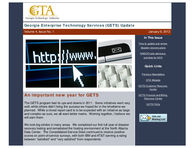Georgia Enterprise Technology Services (GETS) Update
Volume 4, Issue No. 1
January 9, 2012
In This Issue
Time to update and review disaster recovery plans
NASCIO sets advocacy priorities for 2012
Quick Links
An important new year for GETS
The GETS program had its ups and downs in 2011. Some initiatives went very well, while others didn't bring the success we hoped for in the timeframe we planned. While a mixed report card is to be expected with an initiative as large and complex as ours, we all want better marks. Working together, I believe we will earn them.
We took big strides in many areas. We completed our first full year of disaster recovery testing and remediated the hosting environment at the North Atlanta Data Center. The Consolidated Service Desk continued to receive positive scores on point-of-service surveys, with both IBM and AT&T earning a rating between "satisfied" and "very satisfied" from respondents.
Previous Newsletters
GTA Website
GETS Customer Resource Center
GETS Financial and Billing Resource Center
GETS FAQs
Here's a snapshot of our progress to date in several key aspects of transformation:
q 14,748 end user workstations refreshed (38% complete) q 208 servers refreshed (64% complete) q 23 sites remediated for IP re-addressing (52% of sites complete) q 343 LAN/WAN devices refreshed (24% complete) q 114 LAN/WAN firewalls decommissioned (14% complete) q 3 PBX systems (18%), 100 key systems (21%) and 4,835 phone sets
(11%) refreshed
We also successfully completed a pilot to test new processes and procedures for server migration, and late last year, we authorized the resumption of server migration and e-mail consolidation at the state data center. Application servers are being relocated from state agencies, and separate e-mail systems in 12 agencies are being consolidated on a single platform.
What's ahead
We are beginning the year on firm footing, with a renewed commitment to increasing agency involvement in decision making and strengthening our working relationship with our GETS service providers.
The IBM team is focusing on sustained success for transformation activities, working with agencies to meet schedule commitments and delivering desired outcomes. Agency feedback confirms that this is a high priority for GETS stakeholders. Improved quality and responsiveness in service delivery will also be critical, along with improvements in overall customer satisfaction, an important measure of success.
In addition to continuing to deliver on voice refresh and other initiatives, AT&T is working to identify potential areas for improvement as well as new services. Among them is unified communications, a service that integrates communications applications on smartphones, notebooks, desktops, laptops, and other wired and wireless devices.
2012 will be an important year for the GETS program, and achieving the progress we all want will require our commitment and collaboration. The full benefits of transformation - operating and cost efficiencies, greater security and
reliability - are well within our grasp, and I am confident that we will realize them for the state enterprise and the Georgians we serve.
Thank you for your ongoing support.
Calvin Rhodes State Chief Information Officer GTA Executive Director
Time to update and review disaster recovery plans
AT&T, IBM and GTA are working with GETS full-service agencies to update and review their disaster recovery (DR) plans. The effort addresses both the AT&T DR plan (recovery of communications within critical agency locations) and IBM DR plan (recovery of critical IT applications and hardware).
Regular updating of plans is an important part of maturing and strengthening the disaster recovery program across the state IT enterprise. As you recall, last August marked the first full year of DR testing, with four exercises successfully completed. Prior to the GETS program, the state had no disaster recovery program for IT.
Updates and reviews ensure that DR plans reflect changes in operating environments and critical applications. Working with agencies to make updates is part of the service IBM and AT&T provide through the GETS program. Completion of plan updates and reviews is scheduled for March 31, 2012.
Back to top
NASCIO sets advocacy priorities for 2012
Information technology's importance to government at all levels increases every year. The National Association of State Chief Information Officers (NASCIO) has been active in promoting a stronger state/federal partnership, particularly in critical infrastructure protection, cyber security, information sharing, business process redesign and the advancement of enterprise architecture.
Chief among NASCIO's priorities for 2012 is promoting greater administrative flexibility for states. Often, guidelines attached to federal funding for programs administered by states do not promote enterprise IT consolidation, shared solutions, infrastructure optimization, virtualization or the integrated channels of services sought by citizens. Progress is being made, but rules concerning the use of federal funds continue to be an impediment to efficiency and cost reduction.
NASCIO believes that all levels of government and the private sector should partner and collaborate in cyber security protection, recovery and restoration. NASCIO is urging the Federal Emergency Management Agency and the Department of Homeland Security to give higher priority to state cyber security grants programs.
National standards for information sharing are another priority for NASCIO. Standards would help to enable collaborative information exchanges across the state government enterprise and with federal and local government partners. NASCIO recommends the adoption of the National Information Exchange Model to help facilitate inter-governmental data exchanges and collaboration across all levels of government.
NASCIO is also calling for collaboration in identity management and verification solutions. As federal, state and local governments issue credentials to constituents for access to facilities or services, robust and interoperable "trust frameworks" for identity and access management are needed. The ability to issue a digital identity with multi-platform credentialing options would reduce risk and improve efficiency for both issuers and users. NASCIO recommends that federal agencies coordinate with states and work toward a standards-based solution.
Back to top
We welcome your comments about service delivery, the state's IT transformation and related topics.
You can submit comments online or call our toll-free number to leave a recorded message.
